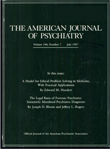Phenomenological correlates of metabolic activity in 18 patients with chronic schizophrenia
Abstract
Using [11C]-deoxy-D-glucose and positron emission tomography (PET), the authors measured brain metabolism in 18 patients with chronic schizophrenia to assess which of the metabolic measures from two test conditions was more closely related to the patients' differing clinical characteristics. The two conditions were resting and activation, and an eye tracking task was used. Patients with more negative symptoms showed lower global metabolic rates and more severe hypofrontality than did the patients with fewer negative symptoms. Differences among the patients were distinguished by the task: sicker patients failed to show a metabolic activation response. These findings suggest that cerebral metabolic patterns reflect clinical characteristics of schizophrenic patients.
Access content
To read the fulltext, please use one of the options below to sign in or purchase access.- Personal login
- Institutional Login
- Sign in via OpenAthens
- Register for access
-
Please login/register if you wish to pair your device and check access availability.
Not a subscriber?
PsychiatryOnline subscription options offer access to the DSM-5 library, books, journals, CME, and patient resources. This all-in-one virtual library provides psychiatrists and mental health professionals with key resources for diagnosis, treatment, research, and professional development.
Need more help? PsychiatryOnline Customer Service may be reached by emailing [email protected] or by calling 800-368-5777 (in the U.S.) or 703-907-7322 (outside the U.S.).



